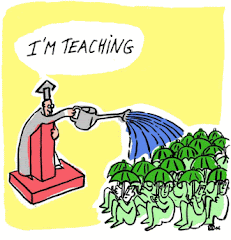2010/01/22
MOTIVATION
- need to pass an exam;
- hope of financial reward;
- possibility of future travel;
- enjoyment of the learning process;
- desire to make oneself better;
- MAKE THE AIMS AND GOALS OF THE COURSE CLEAR well in advance and draw the attention of the students to the achievement of these.
- SHOW INTEREST IN THE STUDENTS AND ENCOURAGE/BE OPEN TO THEIR INTERESTS.
- INTEGRATE THE CULTURAL DIMENSION OF THE LANGUAGE
- INVOLVE STUDENTS IN DISCUSSIONS ABOUT YOUR APPROACH AND RESPOND FLEXIBLY TO THEIR EXPECTATIONS.
- IDENTIFY YOUR LEARNERS NEEDS AND TAKE THESE INTO ACCOUNT.
- DEVOTE TIME AND ATTENTION TO GROUP DYNAMICS (Choose activities not only for reasons of language learning, but also because they may foster positive communal feeling)
- REGULARLY DEMOSTRATE PROGRESS THROUGH REPEATING ACTIVITIES/EXERCISES/TESTS OR SHOWING THEM WHAT THEY DID SOME TIME BEFORE.
- PURSUADE/CONVINCE THEM THAT HAVING TRUST IN INITIAL LEARNING ACTIVITIES WILL LEAD TO ‘SUCCESS’
2010/01/20
THE ROCKS STORY
Wellcome!
- - help and encourage teachers to revisit and develop further their individual philisophy of teaching ESP;
- - involve teachers in reflecting on learning;
- - create opportunities for teachers to share, discuss and try out ideas, technologies, activities and teaching materials;
- - provide teachers with key strategies and skills for continuing professional self-development;
- - enable teachers to explore individually areas of professional interest in ESP;
- - increase teachers' professional competence and confidence.
2010/01/16
2008/03/25
AUTHENTICITY
Reflect on the following definitions of authenticity/authentic materials and choose one or two that seem most relevant to your own teaching context.
1. For the traditional ESP practitioner, there was no simplification of real discourse for pedagogical purposes; instead, authentic, unmodified oral and written texts were provided for students at every proficiency level. A new definition for authenticity has arisen which considers the authenticity of strategies and activities instead of the authenticity of discourse.
(Ann M. Johns)
2. Pure, authentic materials are not possible in ELT classroom, e.g. an article cut from a real newspaper used in whatever way in class is no longer authentic. But what we can have is quasi-authentic material, either real or written in authentic style that is treated in class in a manner close to how it is used in the real world.
(Pat McLaughlin)
3. Authentic texts can actually be created by the ESP teacher or student, as long as they follow the regular rhetorical pattern.
4. 'Authentic materials' are 'genuine' materials removed from their real-life context for use in a communicative classroom.
(Mike Scholey)
2008/03/18
TYPES OF SYLLABUSES
Dear colleagues, while reading the descriptions of different types of syllabuses think about the principles behind each type of syllabus.
1. Grammatical
A list of grammatical structures, such as the present tense, comparison of adjectives, relative clauses, usually divided into sections graded according to difficulty and/or importance.
2. Lexical
A list of lexical items (girl, boy, go away . . .) with associated collocations and idioms, usually divided into graded sections. One such syllabus, based on a corpus (a computerized collection of samples of authentic language) is described in Willis, 1990.
3. Grammatical-lexical
A very common kind of syllabus: both structures and lexis are specified: either together, in sections that correspond to the units of a course, or in two separate lists.
4. Situational
These syllabuses take the real-life contexts of language uses as their basis: sections would be headed by names of situations or locations such as 'Eating a meal' or 'In the street'.
5. Topic-based
This is rather like the situational syllabus, except that the headings are broadly topic-based, including things like 'Food' or 'The family'; these usually indicate! fairly clear set of vocabulary items, which may be specified.
6. Notional
'Notions' are concepts that language can express. General notions may include 'number', for example, or 'time', 'place', 'colour'; specific notions look more like vocabulary items: 'man', 'woman', 'afternoon'. For an introduction to the topic of notional syllabuses see Wilkins, 1976.
7. Functional-notional
Functions are things you can do with language, as distinct from notions you can express: examples are 'identifying', 'denying', 'promising'. Purely functional syllabuses are rare: usually both functions and notions are combined, as for example in Van Ek, 1990.
8. Mixed or 'multi-strand'
Increasingly, modern syllabuses are combining different aspects in order to be maximally comprehensive and helpful to teachers and learners; in these you may find specification of topics, tasks, functions and notions, as well as grammar and vocabulary.
9. Procedural
These syllabuses specify the learning tasks to be done rather than the language itself or even its meanings. Examples of tasks might be: map reading, doing scientific experiments, story-writing. The most well-known procedural syllabus is that associated with the Bangalore Project (Prabhu, 1987).
10. Process
This is the only syllabus which is not pre-set. The content of the course is negotiated with the learners at the beginning of the course and during it, and actually listed only retrospectively (Candlin, 1984; Clarke, 1991).
Source: Ur, P. (2002) A Course in Language Teaching. Cambridge: CUP, pp.178-9

